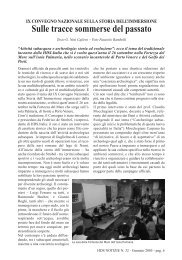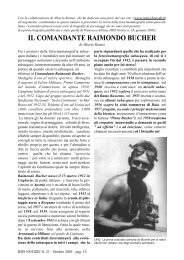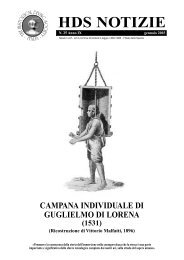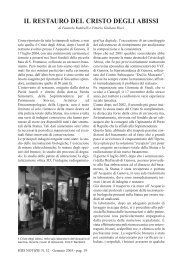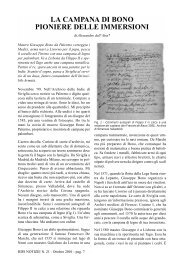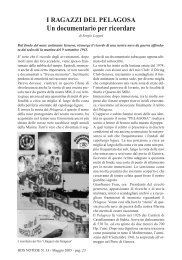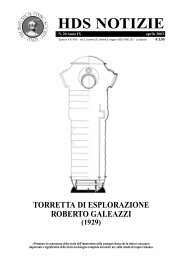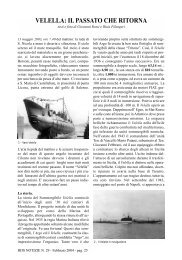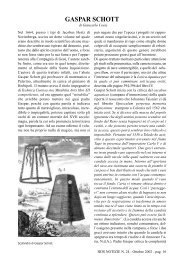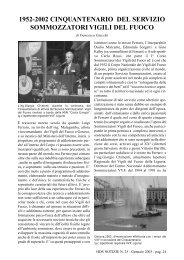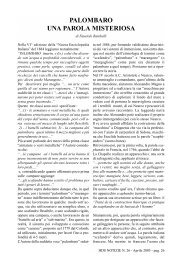HDS NOTIZIE N. 27 - Luglio 2003 - Historical Diving Society Italia
HDS NOTIZIE N. 27 - Luglio 2003 - Historical Diving Society Italia
HDS NOTIZIE N. 27 - Luglio 2003 - Historical Diving Society Italia
Create successful ePaper yourself
Turn your PDF publications into a flip-book with our unique Google optimized e-Paper software.
mani e piedi;<br />
la possibilità di emergere di sua volontà.<br />
Il suo concetto di base è molto semplice e logico.<br />
E’ convinto che in uno spazio, lo scafandro in<br />
questo caso, dove si consuma il gas ossigeno lui<br />
ne avesse fornito dell’altro avrebbe ristabilito l’equilibrio<br />
preesistente in natura. E lui, con suo<br />
HCHTYOSANDRE riuscì a rifornire il palombaro<br />
dell’ossigeno da lui consumato durante l’immersione.<br />
Vediamo dunque cosa scrive Touboulic:<br />
L’ossigeno.A quell’epoca l’elemento ossigeno<br />
era stato da poco scoperto, ma come ottenerlo<br />
non era ancora ben definito, per cui la sua produzione<br />
era effettuata nei modi più disparati.<br />
Touboulic, nella prima lettera dice solo che la<br />
riserva di ossigeno per il suo palombaro era chiusa<br />
in un contenitore che comunicava con l’interno<br />
dello scafandro tramite un rubinetto e che:<br />
“…le gas oxigène s’obtien du Précipité pur de<br />
l’oxide de manganèse de muriate sur oxigène de<br />
potasse & j’en obtiens aussi par le moyen du parfum<br />
de M. Guyton Morveau, en moindre quantité…”<br />
(…il gas ossigeno si ottiene dal precipitato<br />
puro dell’ossido di cloruro di manganese su ossido<br />
di potassio e ne ottengo anche per mezzo del<br />
profumo di M. Guyton Morveau, in minor quantità<br />
…).<br />
Nella seconda lettera, sempre a proposito dell’ossigeno<br />
Touboulic precisa:<br />
“…dans ce flacon de 5 centimètres cubes de<br />
capacité, je mettais 10 grammes environ d’un<br />
melange de muriate de soude et d’oxide noir de<br />
manganèse sur 5 à 6 grammes d’acide sulfurique.<br />
Je faisais ce melange avant de descendre …”<br />
(…in questo flacone di 5 cm cubi di capacità,<br />
mettevo 10 grammi circa di una miscela di cloruro<br />
di sodio e di ossido nero di manganese su 5-6<br />
grammi di acido solforico. Facevo questa miscela<br />
al momento di immergermi …).<br />
L’anidride carbonica.<br />
Spiega Touboulic:<br />
“…poiché l’espirazione fornisce più acido carbonico…<br />
e che la sua abbondanza è dannosa alla<br />
respirazione, ho posto all’interno della mia macchina<br />
delle spugne imbevute di acqua di soda.<br />
L’assorbimento (dell’anidride carbonica) si fa<br />
con questo mezzo…”<br />
Le immersioni.<br />
Nella lettera del 30 maggio 1808 Touboulic, dopo<br />
these disadvantages by supplying his diver with:<br />
an self-contained fresh air supply, without any<br />
external aid;<br />
the possibility of moving on the bottom of the sea<br />
and full mobility of hands and feet;<br />
the possibility of surfacing when wished.<br />
His basic concept is very simple and logical. He is<br />
convinced that in a space, in this case the diving<br />
suit, where oxygen gas is used if he could provide<br />
more gas he could re-establish the equilibrium<br />
that exisits in nature. And with his HICHTYO-<br />
SANDRE he managed to supply the diver with the<br />
oxygen used during the dive.<br />
Let us then have a look at what Touboulic writes:<br />
Oxygen.<br />
At that time oxygen had only recently beendiscovered,<br />
but it was still not well known on how to<br />
obtain it and so its production was carried out in a<br />
variety of different methods.<br />
Touboulic, in his first letter says only that the oxygen<br />
supply for his diver was enclosed in a container<br />
connected with the inner of the diving suit via<br />
a tap and that<br />
“…le gas oxigène s’obtien du Précipité pur de<br />
l’oxide de manganèse de muriate sur oxigène de<br />
potasse & j’en obtiens aussi par le moyen du parfum<br />
de M. Guyton Morveau, en moindre quantité…”<br />
(…the oxygen gas is obtained by a pure precipitate<br />
of Manganese chloride oxide on<br />
Potassium oxide and I also obtain it via the M.<br />
Guyton Morveau perfume, but in smaller quantities…).<br />
In the second letter, still on oxygen, Touboulic<br />
explains:<br />
“…dans ce flacon de 5 centimètres cubes de capacité,<br />
je mettais 10 grammes environ d’un melange<br />
de muriate de soude et d’oxide noir de manganèse<br />
sur 5 à 6 grammes d’acide sulfurique. Je faisais ce<br />
melange avant de descendre …” (…in this 5 cubic<br />
cm bottle, I add roughly 10 grams of a mixture of<br />
Sodium chloride and black Manganese oxide into<br />
5-6 grams of sulphuric acid. I would prepare this<br />
mixture just before going diving…).<br />
Carbon dioxide.<br />
Touboulic explains:<br />
“…as exhaling creates more carbon dioxide…<br />
and in abundance it is harmful to breathe in, I placed<br />
inside my apparatus sponges soaked in soda<br />
water. The absorption (of the carbon dioxide) is<br />
performed by this means...”<br />
<strong>HDS</strong> <strong>NOTIZIE</strong> N. <strong>27</strong> - <strong>Luglio</strong> <strong>2003</strong> - pag. 16



